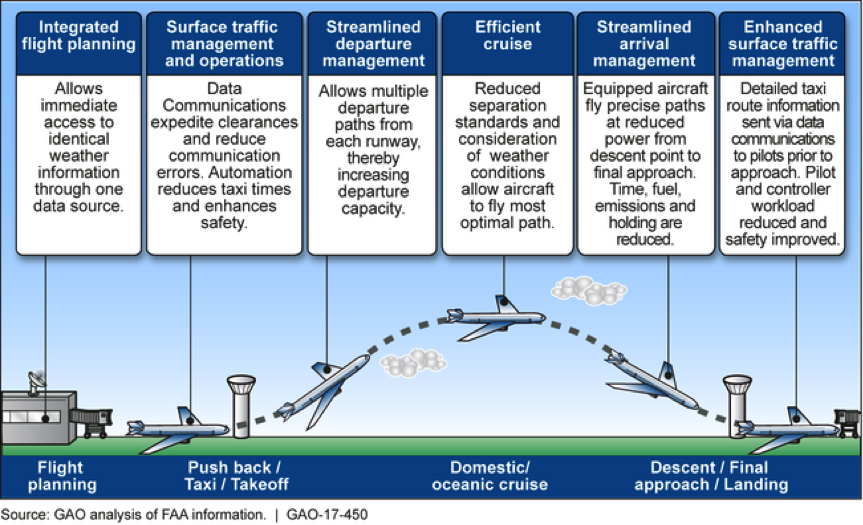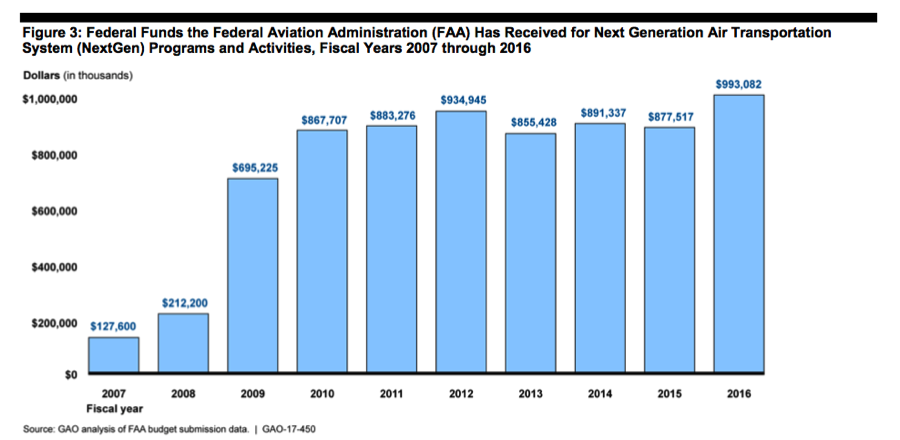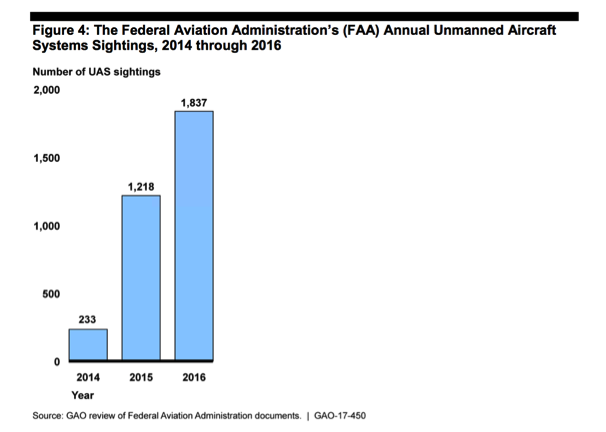September 19, 2017
Earlier this month, the Government Accountability Office (GAO) made available another report on the Federal Aviation Administration’s (FAA) deployment of NextGen, the agency’s multi-decade modernization program (see picture below for the benefits of NextGen throughout a flight). The report, titled “Air Traffic Control Modernization: Progress and Challenges in Implementing NextGen” is generally positive about the agency’s efforts, but cautions about future challenges.

Offering a more positive view than a late 2016 report from U.S. Department of Transportation’s Inspector General (IG), this new GAO report highlights FAA’s success in deploying DataComm (a form of text-based communication between controllers and pilots that is more precise and effective than communicating over radio) and the agency’s engagement with stakeholders (who in fact pressed the FAA to focus on deploying DataComm so the users could start to see some benefits from NextGen soon). The report also praises the agency for implementing most of GAO’s previous recommendations.
On NextGen budget and timeline, the report cites FAA officials who claim that “NextGen programs are generally on schedule” and most of the program will be deployed by 2025 as initially projected. This is a conclusion in contrast to last year’s IG report, which stated that 5 out of 6 NextGen key programs have been delayed on average by five years (the one that was not delayed—and which is in fact ahead of schedule—is DataComm). On the budget issue, GAO notes that FAA’s predicted budget through 2030 is $20.6 billion, which is within the $15-$22 billion interval that was forecast back in 2007 (below is the money already spent on NextGen through FY2016). However, the GAO also points out that these comparisons are difficult because NextGen has changed a great deal since 2007, with some projects being cancelled and others being added to the NextGen umbrella.

The report discusses the challenges that the FAA might face in the future. One of them is the spin-off of the air traffic control function into an independent entity. Other is uncertain funding (many of the proponents of that spin-off argue that this uncertain funding is one of the reason why air traffic control needs to move out of the government). Another reason is the instability in FAA leadership, with a new FAA Administrator expected by next year, as the 5-year term of Michael Huerta ends. “Community outreach for environmental concerns” is also listed as a potential challenge: communities not too happy with changes in the airspace in their region (with more flights over some houses, as NextGen procedures, as they are more precise, tend to concentrate flight paths over narrower pieces of land). We saw some of those concerns this week, with Maryland’s governor telling his Attorney General to sue the FAA because of this.

Finally, the GAO highlights potential issues with airspace users, both current and new. On the current users, equipage remains an issue: aircraft owners are not equipping their aircraft with the necessary equipment to make use of NextGen technologies and without that equipment in aircraft the FAA might not be able to make use of technologies it has deployed. By 2020 more than 100,000 aircraft, or around 85 percent of all commercial and general aviation aircraft will have to be equipped. On the new users, drones and commercial space, drones are the most problematic, as when NextGen was first envisioned they were not a reality yet, and now there are more than 770,000 registered drone operators that need to be integrated safely into the airspace. In the last couple of years, the number of drone sightings, many potentially dangerous, increased several-fold (see chart at right).
For more on the issue of ATC reform see our February report Time for Reform: Delivering Modern Air Traffic Control, as well as our FAA Reform Reference Page, which includes everything related to ATC reform (and aviation legislation in general).
P.S.: This is my last article in ETW—and how appropriate it is that the article is about yet another report on NextGen, the topic that brought me to Eno to be the main researcher for the NextGen Working Group, now the Aviation Working Group. Last week was my last at Eno, and I’ll be moving to the United Kingdom next month. It has been a pleasure writing for ETW. I hope you enjoyed my coverage of aviation topics.






